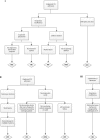Delayed Recognition of Deterioration of Patients in General Wards Is Mostly Caused by Human Related Monitoring Failures: A Root Cause Analysis of Unplanned ICU Admissions
- PMID: 27537689
- PMCID: PMC4990328
- DOI: 10.1371/journal.pone.0161393
Delayed Recognition of Deterioration of Patients in General Wards Is Mostly Caused by Human Related Monitoring Failures: A Root Cause Analysis of Unplanned ICU Admissions
Abstract
Background: An unplanned ICU admission of an inpatient is a serious adverse event (SAE). So far, no in depth-study has been performed to systematically analyse the root causes of unplanned ICU-admissions. The primary aim of this study was to identify the healthcare worker-, organisational-, technical,- disease- and patient- related causes that contribute to acute unplanned ICU admissions from general wards using a Root-Cause Analysis Tool called PRISMA-medical. Although a Track and Trigger System (MEWS) was introduced in our hospital a few years ago, it was implemented without a clear protocol. Therefore, the secondary aim was to assess the adherence to a Track and Trigger system to identify deterioration on general hospital wards in patients eventually transferred to the ICU.
Methods: Retrospective observational study in 49 consecutive adult patients acutely admitted to the Intensive Care Unit from a general nursing ward. 1. PRISMA-analysis on root causes of unplanned ICU admissions 2. Assessment of protocol adherence to the early warning score system.
Results: Out of 49 cases, 156 root causes were identified. The most frequent root causes were healthcare worker related (46%), which were mainly failures in monitoring the patient. They were followed by disease-related (45%), patient-related causes (7, 5%), and organisational root causes (3%). In only 40% of the patients vital parameters were monitored as was instructed by the doctor. 477 vital parameter sets were found in the 48 hours before ICU admission, in only 1% a correct MEWS was explicitly documented in the record.
Conclusions: This in-depth analysis demonstrates that almost half of the unplanned ICU admissions from the general ward had healthcare worker related root causes, mostly due to monitoring failures in clinically deteriorating patients. In order to reduce unplanned ICU admissions, improving the monitoring of patients is therefore warranted.
Conflict of interest statement
Figures



References
-
- Wilson RM, Runciman WB, Gibberd RW, Harrison BT, Newby L, Hamilton JD. The Quality in Australian Health Care Study. Med J Aust. 1995;163(9):458–71. - PubMed
-
- Leape LL, Brennan TA, Laird N, Lawthers AG, Localio AR, Barnes BA, et al. The nature of adverse events in hospitalized patients. Results of the Harvard Medical Practice Study II. N Engl J Med. 1991;324(6):377–84. - PubMed
MeSH terms
LinkOut - more resources
Full Text Sources
Other Literature Sources

